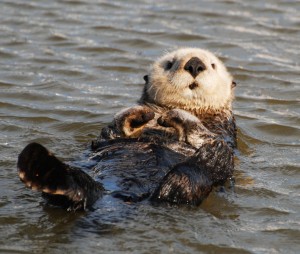We have much more to do and your continued support is needed now more than ever.
Sea Otters: More than Just a Cute Face

As a cash-strapped college student, one of my favorite ways to pass the time (ahem, apart from studying) was to watch the sea otters from the spectacular cliffs of West Cliff Drive—I’d sometimes spend hours watching them fluffing up their fur with their paws, waving to passersby (true story), wrapping themselves in kelp or holding hands to avoid drifting apart, and breaking open sea urchins by whacking them against a rock on their chest.
Little did I know that in addition to providing the cutest entertainment around, these otters were playing a powerful role in tackling climate change.
How Sea Otters Fight Climate Change
Sea otters love eating sea urchins—scavengers known to devastate kelp forests when populations are left unchecked. More sea otters mean more kelp, and since kelp is particularly good at capturing carbon through photosynthesis, this also means less climate-change inducing carbon dioxide in the atmosphere.
According to new a study published in the journal “Frontiers in Ecology and the Environment,” by James Estes and Chris Wilmers—scientists at UC Santa Cruz—kelp beds with a healthy otter population absorb 12 times as much carbon dioxide as beds without otters present.
This is just one example of the tangible benefits of living in a world with strong and healthy ecosystems. Sea otters, brought back from the brink of extinction and still in jeopardy today, provide enormous benefits for the future of our planet.
“Right now, all the climate change models and proposed methods of sequestering carbon ignore animals. But animals the world over, working in different ways to influence the carbon cycle, might actually have a large impact,” said Wilmers. “If ecologists can get a better handle on what these impacts are, there might be opportunities for win-win conservation scenarios, whereby animal species are protected or enhanced, and carbon gets sequestered.”
The Difference Between Sea Otters and Presidential Candidates
This summer has been the season that climate change has become real to many Americans. From severe heat waves, devastating wildfires, catastrophic floods, serious crop damage, and destructive pests expanding their range; people and wildlife have suffered the impacts that scientists have predicted for years.
In reviewing independent data, National Wildlife Federation experts concluded that the weather of 2012 has broken records. The past 12 months were the warmest ever recorded in the U.S., with more than 113 million people in areas under extreme heat advisories as of June 29. July was the warmest July on record and the warmest month ever recorded.
Despite how devastating as all of these impacts have been, the presidential candidates have not done a good job of publicly articulating their plans for addressing the climate crisis. At this point, it seems we have a better idea of what sea otters are doing to reduce carbon pollution than what the next leader of our country will do.
The first presidential debate is on October 3rd and this is the time to hear how President Obama and Governor Romney plan to address climate change.
![]() Climate change is the biggest threat to wildlife today–speak up to make sure it’s on the agenda at the upcoming debates.
Climate change is the biggest threat to wildlife today–speak up to make sure it’s on the agenda at the upcoming debates.





















